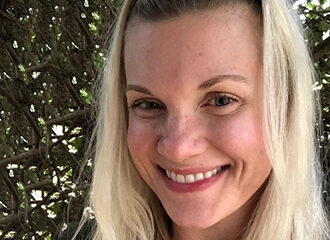Written by: Samantha DeCaro, PsyD
Director of Clinical Outreach and Education, The Renfrew Center
 Eating disorder recovery is a non-linear and unique journey for each person. However, many people share similar experiences not only during the healing process, but also before the work even begins. In this post we look at the stages of eating disorder recovery through the lens of the 5 stages of change.
Eating disorder recovery is a non-linear and unique journey for each person. However, many people share similar experiences not only during the healing process, but also before the work even begins. In this post we look at the stages of eating disorder recovery through the lens of the 5 stages of change.
When we set out to change a behavior or pattern of behaviors, researchers Prochaska and DiClemente (1983) theorized that many of us will go through 5 distinct stages of change: Pre-contemplation, Contemplation, Preparation, Action, and Maintenance. Let’s look at eating disorder recovery through this lens to better understand the thoughts, emotions, and behaviors that can sometimes occur in these stages, including what might keep someone stuck in a stage and what might be needed to move them forward.
Pre-contemplation Stage
In this stage, the person with an eating disorder is not yet thinking about change at all. Someone in this stage might not yet be aware that their behaviors are causing them harm or that their symptoms will cause them harm in the future. There may be denial or minimization that there is a problem, especially if the eating disorder behaviors are initially met with reinforcing praise about their appearance, weight, or character traits.
What work is involved?
Someone might be in the pre-contemplation stage because they don’t yet know what an eating disorder is, or they may mistakenly believe that eating disorders can only happen to thin, white, teenage girls.
The people and supports around them – friends, family, and maybe even treatment providers – also might not have the education or training needed to recognize the signs and symptoms that something’s wrong, further delaying assessment, diagnosis, and treatment.
With all the misinformation circulating from the diet, fitness, and wellness industries, there might even be a belief that behaviors like over-exercise and restriction are healthy, making it even more difficult to imagine why they would ever want to change what they’re doing.
How to navigate it
Empathy and compassion are crucial when someone is in the pre-contemplative stage. There may be resistance to treatment partly because these patterns are serving an important function in some way, and the damage they may cause is not yet in their conscious awareness.
It can be helpful in this stage to take a closer, non-judgmental look at the short term and long-term consequences of the behaviors and patterns. For example, it might be useful to observe all the mental, physical, and social outcomes of focusing so much time and mental energy on food and weight.
Psychoeducation about eating disorders and eating disorder treatment might also be helpful in this stage, including understanding the devastating effects an eating disorder invariably will have across nearly every domain of life. Eating disorders are emotional disorders, so facts and logic will usually not be enough to advance someone into the next stage. This stage usually requires non-judgmental observations, reflection, compassion, and psychoeducation to gradually improve awareness about the dangerous reality of the situation.
Contemplation Stage
In the contemplation stage, the person with an eating disorder is not completely sure there is a problem but is now open to the possibility that something might not be working for them. They might be noticing increased anxiety, difficulties in relationships, or trouble enjoying the things that once mattered a great deal to them. Their world might start to feel much smaller or maybe they wish the obsessive thoughts and intense urges to use symptoms would just stop.
What work is involved?
Ambivalence is a normal experience that might surface during any stage, but it is especially common in the contemplation stage. There could be many valid reasons someone is on the fence about taking the next step toward change. For example, struggling with an eating disorder that is not well known or restricting while living in a larger body can feel invalidating and confusing due to the misconceptions, stigma, biases, and myths about what an eating disorder really is and who’s at risk of developing one.
It might be tempting to minimize certain behaviors when you don’t look like the stereotypical eating disorder patient reflected in the media, or your symptoms aren’t neatly fitting into the very specific criteria for more well-known eating disorders, like anorexia, bulimia, or binge eating disorder.
Someone might also be conflicted about change if the eating disorder symptoms are providing a false sense of control during a time of transition, distracting from a painful loss, offering a form of safety within an oppressive system, or creating a sense of identity or achievement. It makes sense someone might feel uncertain about recovery if the eating disorder has been serving a powerful function or offering immediate, short-term relief.
Other common barriers that can keep someone stuck it the contemplation stage include the thought of not being “sick enough” for treatment or change. This thought is quite common, especially among folks who tend to compare themselves to others. Others might intend to get better one day soon, hoping for the “perfect” time to recover and delaying treatment to focus on work, school, or other obligations. These thoughts and emotions can make it very difficult to ask for the help that is needed and advance to the next stage.
How to navigate it
Eating disorders thrive in isolation and are fueled by shame and secrecy. The contemplative stage is a good time to seek out support by telling someone you trust about the ambivalence you’re experiencing.
It can be helpful to listen to the stories of people who have been through treatment or are in recovery and doing well. Reading or hearing the details of someone’s recovery journey can sometimes help foster hope and inspire the courage needed to make that first call for help. You can find recovery stories written by alums published in our quarterly newsletter Connections. There are also podcast episodes highlighting recovery stories on All Bodies. All Foods.
The Decisional Balance tool used in Renfrew’s Unified Treatment Model can be used to examine all the pros and cons of change as well as all the pros and cons of staying the same. Taking a detailed, non-judgmental inventory of all sides to a situation can be a powerful strategy when feeling ambivalent about change and stuck in the contemplation stage.
Preparation Stage
In the preparation stage, typically after much contemplation, there is newfound willingness to change and motivation to create a plan to get better. This stage usually involves gathering information about recovery and asking for the emotional and/or practical support needed not only to create, but also follow through with your plan.
What work is involved?
The preparation stage might involve identifying resources, researching treatment options, requesting medical leave from work or school, scheduling appointments with medical or mental health providers, or touring treatment program campuses.
There may also be feelings of frustration, anger, or grief in this stage, especially for marginalized folks facing inequities, stigma, or other systemic barriers to receiving an assessment and timely diagnosis.
How to navigate it
The preparation stage is a good time to reach out for assistance, guidance, and support rather than trying to navigate it alone. Many treatment centers understand that this stage can sometimes feel scary and confusing, which is why many programs have put systems in place to help prospective patients through this process.
For example, there are Program Information (PI) Specialists available at Renfrew trained to confidentially answer questions, address concerns, and help navigate next steps over the phone. A PI specialist can also help with scheduling the first intake assessments.
There is also a Live Chat feature on many websites that allows you to send a message to a representative of a treatment program. This can be another way to ask questions and gather the information you need before moving into the Action Stage.
Action Stage
In the action stage, typically there is a plan for recovery and the patient is following through with the plan they created. For those fortunate enough to access treatment, many folks in the action stage have usually completed an assessment, received a diagnosis for their eating disorder, and entered a level of care that best meets their needs.
What work is involved?
Eating disorders are complex psychiatric disorders, and the work in the action stages goes far deeper than just stabilizing eating disorder and medical symptoms. For example, it might include experimenting with new skills, building emotional tolerance, expressing emotions and needs, identifying core values, unpacking internalized biases, processing trauma, reconnecting with the body, and strengthening relationships.
The action stage might also include attending support groups, reading blogs or books about recovery, watching educational webinars, or participating in local recovery events. Folks in this stage are actively seeking change and often find healing and comfort within an accepting and validating community of others who are doing the same.
How to navigate it
Motivation will likely fluctuate in this stage and progress will not be linear. By improving awareness and self-compassion, it becomes easier to navigate and learn from the inevitable slips and rough patches on the road of recovery.
The Action Stage can sometimes feel frustrating or overwhelming, especially if treatment goals feel too big or too vague. Developing small, concrete, do-able goals can be a helpful strategy during this stage.
The “Taking the Necessary Steps” tool from Renfrew’s Unified Treatment Model can serve as a guide when breaking down big aspirations into concrete, measurable steps. An interdisciplinary treatment team can help guide and assess the progress made towards medical, psychological, and social goals. Gradually, the same amount of structure, support and supervision might not be necessary, resulting in a step-down to a lower level of care or less frequent sessions with your outpatient team.
Maintenance Stage
The Maintenance Stage generally includes managing symptoms by using all the tools, support, and knowledge you’ve collected along your recovery journey. Everyone defines their recovery in their own way. For example, some might say they are “in” recovery, and the eating disorder is something that is managed with ongoing support, while others might consider themselves fully recovered, building in support as needed. This stage often includes living a life aligned with core values and expanding life beyond recovery by learning new things, nurturing relationships, taking on new challenges, or resurrecting old hobbies and passions.
What work is involved?
The work previously done in the action stage should hopefully provide a foundation of knowledge, skills, support, and self-awareness to achieve sustainable change. For example, the Action Stage often provides plenty of opportunities to practice asking for support, tolerating urges, and responding to ED thoughts with curiosity and self-compassion. There are many folks in the maintenance stage that feel strong enough in their recovery to spread hope that recovery is possible by speaking at alumni reunions or volunteering to be a guest speaker for The Voices of Recovery Group at Renfrew’s residential program in Philadelphia, PA.
How to navigate it
In this stage, there is an awareness that there is no such thing as a perfect recovery. Slips sometimes happen, and there is a willingness to learn from them by identifying triggers, reaching out for support, and creating a plan to respond differently next time.
A Relapse Prevention Plan can be a helpful tool during the Maintenance Stage, especially when it includes the unique red flags that indicate more support or structure is needed, a list of resources and supports, and a collection of helpful tools and skills to use as needed.
Many people in this stage understand that relapses are sometimes part of the journey, and re-entering treatment might be necessary at some point in the future. Sustainable change might require a return to an earlier stage or going through all of the stages again.
Conclusion
No two recovery stories are identical, and each person will have their own unique path and perspective. Many find comfort knowing that there are typically some shared experiences along the way, helping to normalize and validate the emotions, thoughts, and behaviors that frequently occur in each phase of change. No matter where you may be on this journey, remember that you’re not alone and you deserve compassion, empathy, and support at every stage.
References: Prochaska, J. O., & DiClemente, C. C. (1983). Stages and processes of self-change of smoking: Toward an integrative model of change. Journal of Consulting and Clinical Psychology, 51(3), 390-395.


